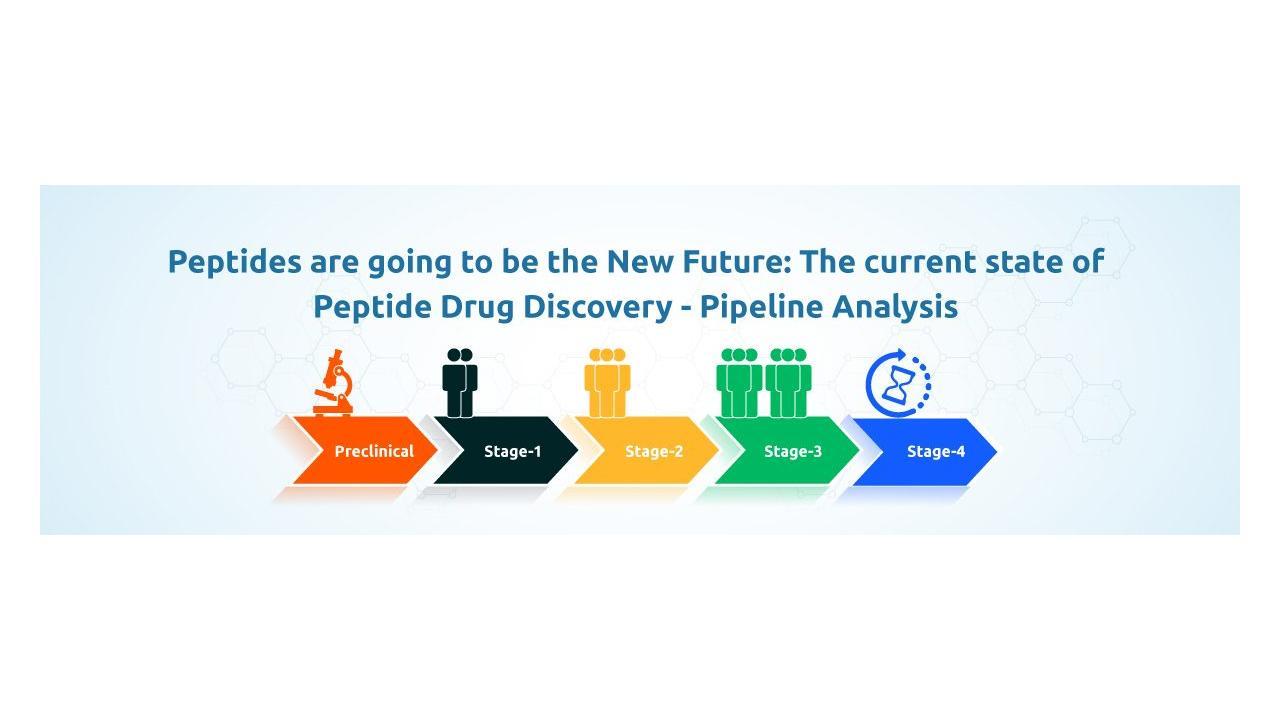Peptide drugs have been in use for almost a century now, though initially they were only used to replicate the action of natural hormones for metabolic diseases

Peptide Drug Discovery Pipeline Analysis
What are peptides?
Peptides are naturally occurring, small biological molecules made of short chains of amino acids linked by a peptide bond, performing multiple functions within the cell. Peptides play a vital role in the overall functionality of an organism as they contain amino acid sequences which control and coordinate all cellular functions and intracellular communication.
ADVERTISEMENT
They have excellent diagnostic, preventive, and curative properties. The diverse functional capability of peptides is determined by the amino acid sequences and shape of the peptides.
Peptide therapeutics
Peptides research and development
Peptide drugs have been in use for almost a century now, though initially they were only used to replicate the action of natural hormones for metabolic diseases, for example, the first of this kind that was approved for clinical usage was insulin for the management of diabetes. Today, several chemical modifications of peptides are achievable for challenging and complex tasks within the organism.
Decades of research & development of peptides have resulted in the discovery of peptides that have the ability to penetrate the cell with advanced actions, all of which have shown excellent results for various therapeutic functions. Peptides exhibit a wide range of functions which include physiological, immunomodulatory, and wound healing functions.
Growth of peptides in different therapeutic areas
Although higher approval rates have been observed for metabolic diseases, several peptides are approved or in the stage of active development for various other medical conditions. The U.S Food and Drug Administration has approved 18 peptides or peptide-containing molecules in the past five years from 2015-2019, accounting for 7% of the total number of new drugs.
The most common indications for peptides are oncology, endocrinology, and metabolic diseases. Other target areas of peptides that have gained attention include gastroenterology, cardiovascular diseases, dermatology, bone diseases, and sexual dysfunction. Due to their highly immunogenic nature, peptide vaccines also have a great potential to become an alternative to classic vaccines as they are completely synthetic and do not cause any unwanted side effects. There has been a great progression of peptide drug discovery over the past decade due to a rise in appreciation of these drugs by the pharmaceutical industry as enhanced biological therapeutics or even alternatives for small molecules.
Several modifications of peptides have been introduced to overcome their limitations. Some of these include cell-penetrating peptides which help in penetration of multiple layers of the cell to reach the target site, cyclic peptides which have diverse biological activities, multifunctional peptides which exhibit more than one pharmacological activity, and plasma half-life extension. Some examples of current multifunctional peptides under development are antimicrobial peptides with immune stimulation and wound healing; anticancer peptides with antimicrobial properties; antidiabetic peptides with obesity prevention.
Peptide delivery technology
Although the preferred method of peptide drug delivery is oral administration, limitations have been observed due to the low oral bioavailability of peptides as a result of degradation in the gastrointestinal tract. Alternatively, subcutaneous and intravenous methods of peptide delivery help to improve absorption. Recent advancements in delivery techniques have been focusing on enhancing the oral bioavailability of peptides for better patient compliance. Some of these include:
- Nanoparticle technologyhas been developed to prevent degradation and provide better absorption of the drug at the intestinal epithelium. In order to avoid mucus barriers in the gastrointestinal tract, mucus penetrating nanoparticles have been developed for improved uptake of the drug.
- Permeation enhancers are used as advanced methods to improve the absorption of peptide drugs. Many compounds such as surfactants, chelating agents, bile salts, etc. have been proven to be effective intestinal permeation enhancers. They increase cellular permeability, decrease mucus viscosity and increase membrane fluidity.
- Self-emulsifying drug delivery systems are composed of lipids, surfactants, and co-solvents. They help in improving the oral bioavailability of peptides by forming microemulsions when mixed with gastrointestinal fluids. Thus, they improve penetration through the mucus layers of the intestine and act as a barrier against metabolism.
Why peptide drugs?
The development of peptide drugs was initiated to achieve a combination of small molecules and proteins as each of these had its own set of advantages and limitations. Numerous natural peptides have served as starting points for the development of peptide therapeutics. For example, the gut microbiome, which is rich in diverse bacteria and other microorganisms, has the potential to give rise to new peptides from protein fragments and degradation products.
Peptide properties
Peptides demonstrate high levels of safety due to decreased toxicity as their degradation products only involve simple amino acids following the desired action on target molecules. They can also be used as an addition to existing pharmaceutical agents in order to direct them to their target areas, modify their biological action and transport them across cellular membranes.
Peptide market growth
The growth of peptides has been increasing year by year starting with 10 peptides in 1980 to more than 150 peptide clinical trials that have been approved to date in Europe, United States, and Japan, and 20 peptide clinical trials taking place every year. An annual growth rate of 9.1% has been predicted for peptide therapeutics from 2016 to 2024. Due to the advancement of technology, formulation, and chemical modifications in recent years, the use of peptides has been on the rise.
The future holds an extensive place for peptides in addressing the greatest of medical challenges due to their capability of being adapted and modified to achieve the desired action. There is immense scope for the development of new peptides with protein fragmentation along with alternative routes of administration and improved oral bioavailability. They will also be used to address the currently undruggable targets in the coming years.
Taking the current developmental pipelines of various peptide R & D companies into consideration, a majority of companies have focussed on oncology and several other therapeutic areas. These developments have been progressing rapidly with most of the peptide drugs in the human clinical trial stages. Emerging interest has also been observed in the areas of gastroenterology, immunotherapy, reproductive and maternal health, obesity, ophthalmology, bones, and joints. These areas are currently being examined in their pre-clinical stage and are soon expected to enter the clinical stage of human trials.
For more info: https://issar.co.in/
 Subscribe today by clicking the link and stay updated with the latest news!" Click here!
Subscribe today by clicking the link and stay updated with the latest news!" Click here!







